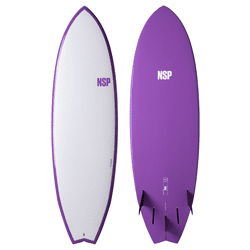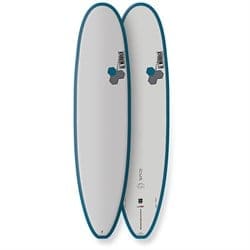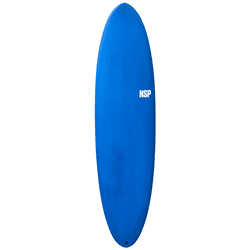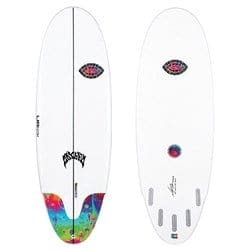|
Getting your Trinity Audio player ready...
|
So you’re finally ready to invest in your own surfboard, but there’s about as many sizes and shapes of surfboards as there are salsas at your favorite taco bar. So how do you go about choosing the best surfboard for you? Well, here’s the end-all-be-all guide to choosing a surfboard. The first step to surfing success is to do some introspection and be honest with yourself about what and how you’ll be riding to get the most out of your new long term relationship. Drop in with us and we’ll help you pick your dream surfboard.
Things to Consider When Choosing a Surfboard
Before you shave your head and go buy Kelly Slater’s pro model, you’ll have to think about if you’re surfing the way the GOAT does. The surfer makes the board, not the other way around and picking out the wrong board for yourself can make your day in the water a lot less fun than it could be. Here’s a few things to consider.
Wave Size & Type
The type of wave you ride regularly has a lot to do with what board you should be riding. Make sure you understand what kind of conditions you’re going to be heading out on. If you’re just looking to cruise around on some ankle-biters, you’ll make different decisions for board choice than if you’re trying to become the pipeline champion.
Ability Level
Board design is generally the art of compromises. For example, shapes often trade stability for maneuverability so finding the right balance for yourself is important. You don’t want the board to be so twitchy that you’re never standing on it, but if you’re looking to perfect your cutbacks, your board can certainly be too stable and not allow you to impress all the babes oiling up on the beach.
Fitness
Surfing is probably one of the most physical outdoor sports you can participate in and board design can help or hinder depending on whether or not your physique resembles Popeye or Olive Oyl. Generally speaking longer, more voluminous boards are easier to paddle, but can be tough to get past whitewater.
Surfboard Characteristics & Design Terms
Surfboard Buoyancy
A surfboard’s buoyancy is how well your board floats and it’s generally referred to by the volume of space your boards take up. Apparently, this term came from outside of the US as it’s referred to in Liters. Buoyancy is important because it provides the lift a board needs when getting up to speed and is key in catching unbroken waves. Part of the reason high volume boards paddle better is because the buoyancy lifts the board and gets it planing (out of the water) faster and reduces drag quickly.
Better paddling surfboards result in being able to take off on a wave at an earlier, shallower portion of the wave which is why longboards and midsize boards made for smaller weaker waves will generally have a lot more volume.
Surfboard Thrust
There’s some funky and cool fluid dynamics and physics that go into propelling a surfboard and “thrust” is a term you’re likely to hear when reading about a surfboard’s characteristics. This is something that comes into play when you begin surfing down the line of an unbroken wave. It’s essentially the characteristic of the board to redirect water coming across its base, towards the tail of the board. Fin configuration and base channeling are some of the main board features that provide this feature. By redirecting water, Newton’s 3rd law comes into play and by pushing water towards the tail of the board, it propels the board and surfer forward.
Surfboard Drive
Drive, in a surfboard, refers to the ability of the board to turn wave and rider input into forward motion. Drive shows up in a number of different characteristics. The flex of the board, the grip of the fins and the rail engagement all contribute to how much drive a board can provide. It’s difficult to quantify as it’s a synergy of so many different factors, but you’ll know when a board has it.
Surfboard Rails
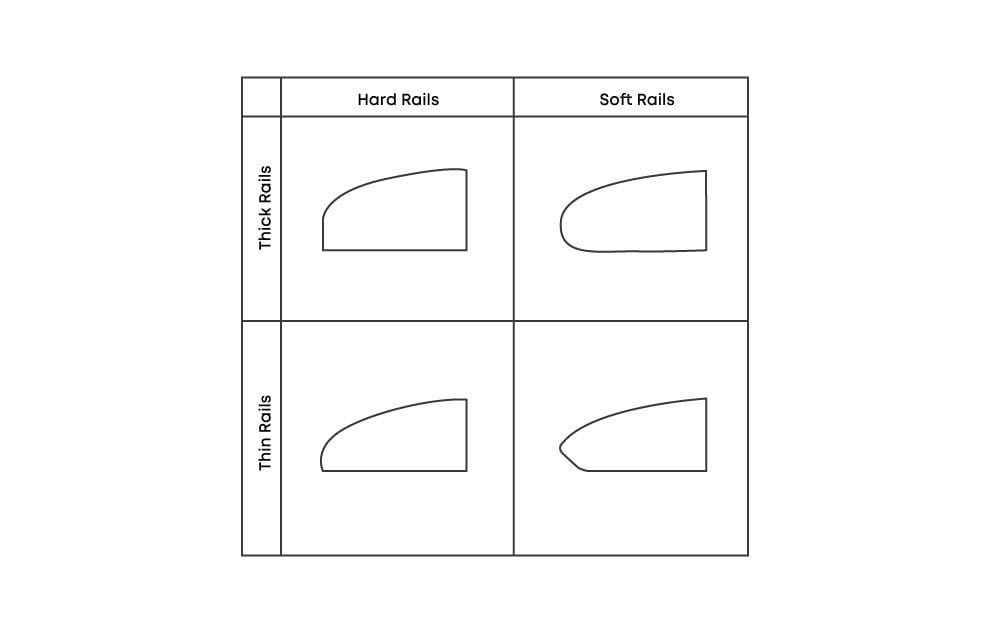
Surfboard Rocker
Surfboard rocker, in simple terms, is how closely your board resembles a banana from the side profile. Boards with less rocker plane on water more efficiently and get up to paddling speed much quicker than heavily rockered boards.
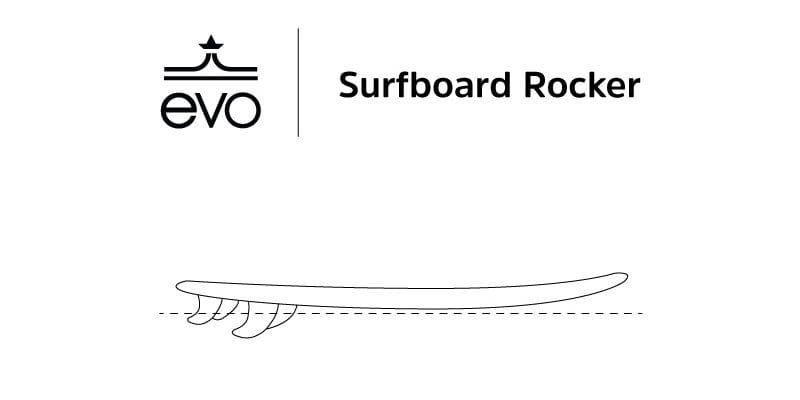
Shop All evo Surfboards
How to Choose the Right Size Surfboard
There’s two main things to consider when determining the right size surfboard – style and volume. First the type of surfing you’re looking to do. Are you looking to cruise around Waikiki with the dog? Or are you working on your backside cutbacks? Stylistically, they’re pretty different, so decide whether or not you’re going over or under 7’ (roughly) for a board. This puts you in the shortboard or longboard realm depending on your preference. Not sure which shape or style fits you? Check out our breakdown of shapes below.
Once you’ve decided if longboarding or shortboarding is more your style, then reference the chart below for choosing the correct volume in liters. Most board shapes come in varying lengths to accommodate riders of differing skill and bodyweight while maintaining the ride characteristics of that shape.
Surfboard Volume
We’ve already talked about buoyancy quite a bit, but here’s how to appropriately determine how much volume a surfboard should have, based on your skill level and body weight.
| Ability Level | Waves/Style | Surfboard Volume |
| First Time/Beginner | Whitewater, Learning to Stand | 2 lbs/L |
| Beginner/Intermediate | Paddling Out, Riding Waves Straight | 3 lbs/L |
| Intermediate | Trimming Down the Line, Shallow Turns | 4 lbs/L |
| Advanced | Aggressive Top to Bottom Surfing | 5+ lbs/L |
Surfboard Nose Shapes
The nose and front half of the surfboard is a good indicator of how the board will perform when paddling. The nose of the board is the first thing that comes into contact with oncoming water. Pointed nose shapes help reduce drag by cutting through the water when paddling as well as reduces swing weight when performing turns. Additionally, it’s less likely to catch a rail in the water when turning as there’s simply less material there to catch.
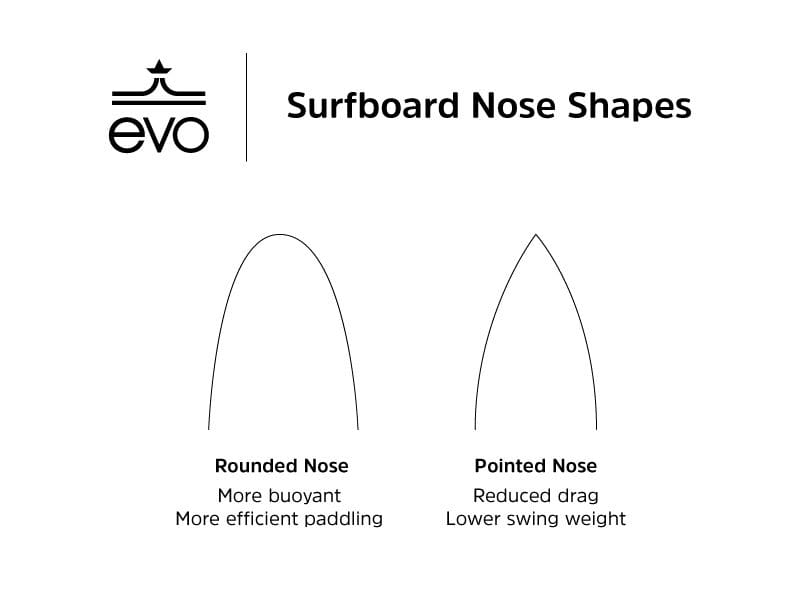
Surfboard Tail Shapes
Since the nose of the board is generally out of the water when we’re actually up and surfing, the tail and back half of the board is a good indicator of how the board will surf while we’re up on our feet and riding. The tail shape primarily dictates how much of the board’s rail is in the water while standing. Lots of rail engagement means lots of lift and stability, but also means that it’s difficult to pull the rail out of the water to initiate a turn.
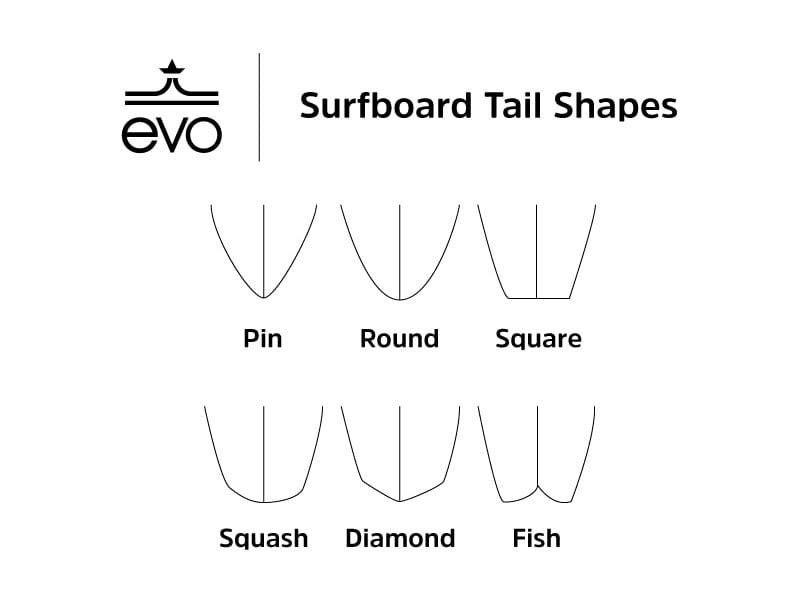
So this gives us the outline of how to think of tail shapes. Pin tails are likely to have less volume and less rail engagement which means more control in powerful waves, but poor performance in weak waves. Conversely a wide squash tail is likely to help generate lift and speed in weak surf, but will not provide great maneuverability when waves are big and powerful.
Swallow tails are a bit of a hybrid – they have the rail profile of a wider tail, but the cutout provides the volume closer to that of a pintail allowing you to dig it into a wave and pivot your turns.
Types & Shapes of Surfboards
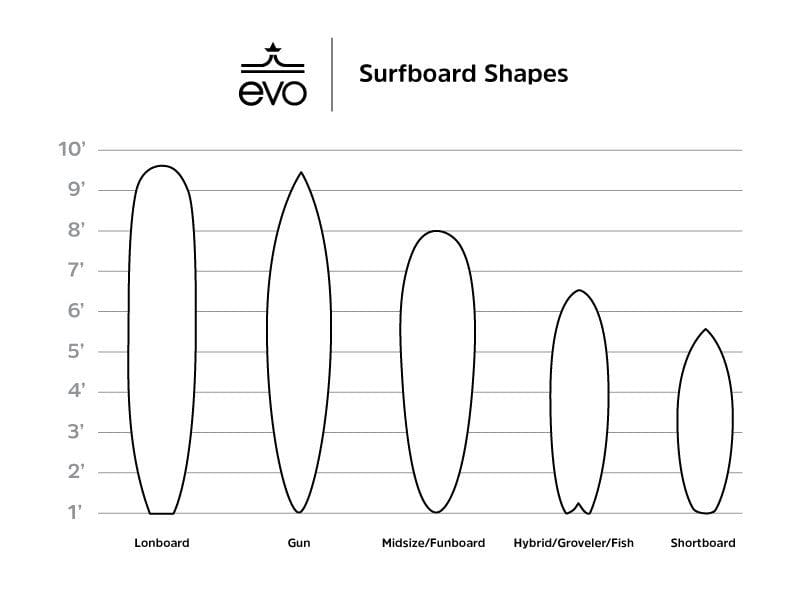
Longboard Surfboards
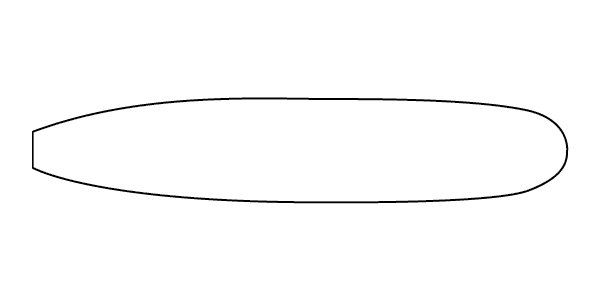
Characteristics: Uber stability, runway for walking around with style and cruisy smooth turns.
Length: 7’6 and above
Fins: Single Fin, 2+1 and occasionally thruster
Previously reserved for hawaiian royalty, longboards are the kings of stability and style. Here, we’re looking at boards generally 9+ feet long and sporting pontoon level (50L+) buoyancy. Single fins and egg-like shapes are most common, though the occasional squash tail and fish tail and occasional thruster/quad fin setups will show up on more exotic models.
Longboards are great for beginners, but a must for anyone who’s looking to improve their surfing ability. The increased volume lets you get out when the swell is small and the rock solid stability helps get more wave-time. These benefits come with tradeoffs, of course. Longboards are more likely to be trimming down the line and making smooth arcing turns rather than pumping and generating speed. Aerial maneuvers on a longboard? I’d pay $20 to see that.
As a result, longboards are a riding style of their own. Smooth and sweeping turns as well as cross-stepping and the famous “hang 10” will get you as much attention in the lineup as a big cutback turn or air.
Midsize Surfboards or Funboards

Characteristics: Stability and high volume for high wave counts.
Length: 7’ to 8’6”
Fins: All of them and then some – quad or thruster,
Lose a foot or two off your longboard, or add a few to your shortboard and you’ll start to enter the realm of the funboard or midsize board. Generally between 7’ and 8’6” we get to more variety in shapes with pointier noses, a tad more rocker and pintails start to come in. You’ll still see single-fin setups here, but quads and thrusters are more and more common.
These boards are for small, weak swells and for novice surfers looking to graduate from their wavestorm get a bit more maneuverability compared to their longboard.
Hybrid, Groveler & Fish Surfboards

Characteristics: Short, maneuverable boards for smaller, weaker waves
Length: 5’ to 6’11”
Fins: Thruster, Quad, Twin
For the surfer who absolutely must ride a shortboard, regardless of how weak the waves are, there’s now quite the variety of short, wide and thicc options available. While the original fish surfboards gained popularity in the 70’s, the intent and design has carried onto modern grovelers.
Fish, hybrid and groveler surfboards are, in many cases, thickened and widened versions of classic shortboard shapes. You’ll see wider, rounder noses are more common as well as plenty of squash and swallow tails with lengths generally under 6. All of these are traits added to short boards which improve their performance in small, mushy waves. You won’t see any more longboard style single fins but the twin fin makes an appearance in this category, keeping it retro like your VW bus.
These boards are great daily drivers for the surfer looking to fit in sessions before or after work and if the swell happens to be firing when you’re in a PTA meeting.
Shortboards

Characteristics: Thin, short and pointy boards for maximizing maneuverability on high quality waves.
Length: 4’8”’ to 6’6”
Fins: Thruster or QuadIf Ricky Bobby wanted a surfboard, he’d be getting all of his nasty bad-ass speed from a shortboard. Here we’re looking at boards generally 6’ and less, narrower profiles and noses sporting knife-thin rails. These boards are all about performance in high quality, powerful waves that you’ll treat like a teenager in a horror slasher flick. Unlike Ricky Bobby, shortboards can turn right and can be a scalpel in the hands of a skilled rider. On the flip side, they are difficult to manage in less than ideal conditions or for a first-time rider. Aerial maneuvers, tube riding, competitions, and anywhere you’d want maximum maneuverability or control is the domain of the shortboard.
Step Up Boards & Gun Surfboards
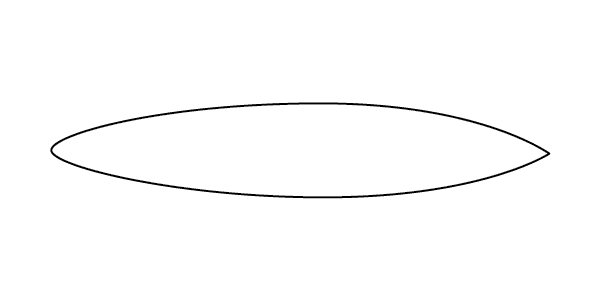
Characteristics: Longer versions of performance shapes for stability in massive surf
Length: 6’6” to 11’
Fins: Thruster or Quad
As waves get bigger and bigger, the traditional shortboard starts to come up short-handed. Step up boards & guns are larger, high-performance boards with outlines that resemble shortboards, but start to approach midsize & longboard lengths. At high speeds and wind common with monster swells, an improvement in stability goes a long way to keeping your head above water.
What Are Surfboards Made Of?
While there are several different popular materials that surfboards are made up of, the most traditional is a foam core covered in fiberglass. Surfboards can have several different core materials that give the board different characteristics. Surfboard construction can also feature foam, epoxy, cork, and other materials.
Fiberglass Surfboards
Fiberglass is the classic, high-performance construction method for shaping surfboards. Typically this takes a foam base with a wooden stringer(for rigidity & flex), wrapped in fiberglass weaved cloth, and then smothered in resin. These boards can be somewhat fragile as a result. Outside of the water, they should be treated with care and mostly kept in a protective bag or cover. Some amount of denting on the deck is somewhat normal as your body weight and foot pressure can compress the foam, but cracks need to be cared for to prevent waterlogging which kills the board’s buoyancy.
What you get in exchange for the fragility is the most beautiful surfboard construction money can buy with great flex patterning and unparalleled performance.
Epoxy Surfboards
If you’re not quite ready for a glass cannon like a fiberglass board, or are stocking a rental fleet, epoxy boards are common substitutes for traditional fiberglass boards. Here instead of a thin resin coating, the boards get a hard epoxy treatment. This dampens the board’s ability to flex a good amount, but handles bouncing around in your vanagon quite a bit better.
Foam or Cork Surfboards
Throw these things in the back of your truck and rush over to that post-ride burrito joint without even taking off the bottoms of your wetsuit. Foam surfboards use durable soft, closed-cell foam to wrap the deck and rails of these boards, keeping your chest from chaffing and providing heaps of buoyancy. Recently some boards have been using cork instead of foam, for nearly identical purposes. Forgot to wax? You’re not likely to slip off these squishy decks anyhow.
Lib Tech Surfboard Construction
Our snowboarding friends over at LibTech also happen to be some cold water fanatics as well. They’ve taken what they know from the snowboard world and made some interesting applications to surf. The Mervin manufacturing boys are using whacky eco-friendly construction to create ultra-durable versions of Lost Surfboard shapes. Would you run over your surfboard with a truck? You could if you wanted to with a Lib Tech board.
How to Choose the Best Beginner Surfboard
The best beginner surfboard you can buy is the board that you have the most fun on. That being said, it’s important to stow your ego and make sure you’re choosing the right board so you’re not just getting slapped around with salt water and actually doing some surfing. For beginner surfers, board choice is especially important.
Riding a wave is actually a very small component of learning to surf, so many characteristics that we’ve been talking about, such maneuverability and speed can become pretty irrelevant. What’s relevant in a good board for a beginner surfer is the ability to paddle out, manage your position in the water, and catch a lot of waves. This means choosing a surfboard with the right amount of volume. For someone who’s a very beginner, this typically means longboards & midsize boards with a LOT of volume. Refer to the above section on surfboard volume and choose accordingly.
Additionally to volume, err on the side of stability when it comes to any other feature of the board such as fins. Beginner surfers are generally working on catching waves and riding straight to the beach while staying upright. Wider bodied boards and a more locked in feel of a big longboard fin, 2+1 fin set up and thrusters simplify things so you can focus on mechanics.
Foam boards are also really popular for beginners as they’re affordable, stable, rock volume that goes to 11 and aren’t nearly as fragile as traditional fiberglass boards can be. It also helps that getting speared in the back with a foam board isn’t nearly as painful as a hard board either. Foamies come in all shapes and sizes and are now even coming in some higher-performance shapes and construction. Overall foam surfboards are a great choice for beginners.
About evo
evo explores the collaboration between culture and sport by seamlessly joining art, music, streetwear, skateboarding, snowboarding, skiing, mountain biking and wakeboarding. Evo’s aim is to bring all things relevant to the urban, action sports lifestyle into one creative space. Whether it is on the website, on the phone or in their stores, evo’s aim is to make all who come into contact with evo feel welcome and excited about their experience.
Evo’s website launched in 2001, after lots of coffee, countless late nights, 100’s of powder days, and early morning sessions on the lake, they are still focused on being a great retailer and asset to the community. evo’s retail locations in Seattle, Portland, and Denver are more than just stores – evo is passionate about creating community anchors in urban settings with diverse groups of people who share common interests. Music events, movie premiers, art exhibitions, benefits to help children in need, partnerships and simply providing a great place in a central location are all ways that they work to build and strengthen community. It is no mistake that evo’s locations are venues, art galleries, and retail spaces all wrapped into one.
Popular Articles:
How to Wax A Surfboard & How to Remove Surf Wax
How To Get Your Snowboard Fix Year Round
Deckers X Lab KO-Z Collection: Weekend Comfort All Week Long
Latasha Dunston Shares How Everyone Has a Place in Nature
Epic Water Filters Launches New Water Dispensers






